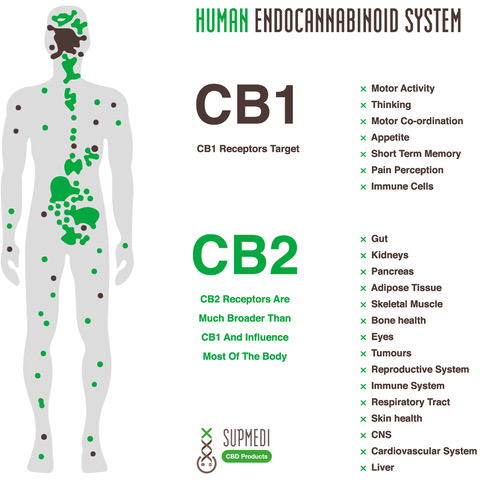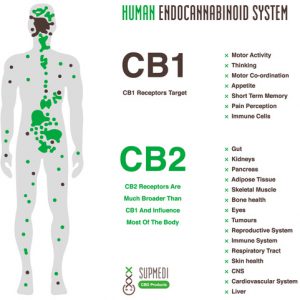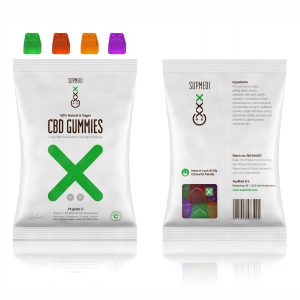
The Endocannabinoid System Explained
10 August 2020For a proper understanding of the many positive effects attributed to substances derived from the cannabis plant, we need to explain the mechanism by which these substances work in the human body. In this article, we shed light on the working of an important part of the human physique: the endocannabinoid system.
The Discovery Of The Endocannabinoid System
The endocannabinoid system was discovered by a team of scientists led by Raphael Mechoulam. They wondered why cannabis appears to have so many different effects on people. On their quest to find out wat cannabis substances actually do inside the body, they stumbled upon the endocannabinoid system. Here, ‘endo-’ means ‘naturally present in the body’, while ‘-cannabinoid’ refers to a range of different substances found in the cannabis plant, such as THC and CBD, for instance. As it turns out, this part of our body has been named after the cannabis plant.

What Does It Do?
The endocannabinoid system is part of our nervous system. The nervous system controls all of our conscious and subconscious activities. In other words: you wouldn’t be able to read this article if you didn’t have a nervous system. There is a whole bunch of other vital processes going on in your body at this very moment, though, such as the beating of your heart and the digestion of your breakfast, which are all guided and controlled by your nervous system.
The endocannabinoid is a very important part of this nervous system. In short, it regulates the balance in your body and your mind. The endocannabinoid system is involved in processes that we need to survive and to feel good. Among the many functions affected by the endocannabinoid system are: sleeping and waking, resistance to disease, mental and physical experience of pain, hormonal balance, clearing away (cancer) cells, metabolism, and energy regulation, storing and forgetting information, to name just a few. Clearly, without this system, we would not be able to survive.
How Does It Work?
Without getting tangled up in technical details, we can say that our body is made up of cells, and these cells need to communicate with each other. Your brain, for instance, has to know that your stomach is empty before it can give you a signal that you should start looking for some food. To do this, the body uses electrical signals that travel along the nervous system. The body also uses messenger substances called neurotransmitters to relay messages from one cell to the next. Cells have receptors to receive these messenger substances. If the right messenger substance attaches to the right receptor, the cell has received the message. Our body has many different kinds of receptors, which can be switched on and off by many different messenger substances.

Messenger Substances Like Adrenalin
Which particular messenger substances are active at any given time depends on the situation. A clear example is adrenalin. Adrenalin is both a hormone and a messenger substance; one of which we all know the affects. When danger is close, or if something startles you, your body releases adrenalin into your bloodstream. This cause your heartbeat to increase, your muscles to tense up, and your pupils to dilate. This is how adrenalin prepares your body to either fight, or to run away. After all, we all want to survive, and this is our mechanism to handle danger.
Endocannabinoid Messenger Substances
The messenger substances that are part of our endocannabinoid system are known as anandamide and 2AG. They are also called endocannabinoids, which means ‘cannabinoids naturally occurring in the body’. These substances are capable of activating the receptors of the endocannabinoid system, called CB1 and CB2 receptors. Unsurprisingly, CB stands for CannaBidiol here. The CB1 receptors are predominantly found in the brain; in fact, it is the most common receptor found in the human brain. CB2 receptors are found throughout the body, with large concentrations in and around the digestive tract. Together, these messenger substances and receptors are constantly working to keep us balanced.
What Does Cannabis Do?
As mentioned earlier, the endocannabinoid system found in our body was named after the cannabis plant. The system is found not just in humans, by the way: other mammals, birds, fish, and even certain jellyfish have it as an important part of their natural anatomy. Substances found in cannabis plants can influence this system, which explains how they can have so many different effects on our body and mind. There is a huge variety of cannabinoids. For our present purposes, we will confine ourselves to two of the most important ones: THC and CBD.
THC
The substance known as TetraHydroCannabinol (THC) is responsible for the sensation of being high. Chemically, THC is very similar to the endocannabinoid anandamide. In fact, the two are so much alike that CB1 and CB2 receptors do not notice the difference between them. These receptors will activate as soon as either anandamide or THC connects with them. When a person uses THC, for instance by using droplets of oil, this will activate many receptors in the endocannabinoid system. After a while, the receptors release THC back into the bloodstream and deactivate. Using THC will cause many more CB receptors to activate than under normal circumstances. This affects the many processes regulated by the endocannabinoid system in turn.
CBD
The substance known as CannaBiDiol (CBD) works in a different way. Research has now demonstrated conclusively that CBD is also able to connect with CB1 receptors. However, CBD connects to a point on the receptor that prevents it from activating. As a result, CB1 receptors that connect with anandamide or THC will be partially dampened by the CBD attached to the same receptor. Compare it to the dimmer you see on certain types of lamps. In this example, the ‘lamp’ is switched on by THC or anandamide. CBD serves as the dimmer here, ‘toning down’ the light as it were. This is how CBD can have a soothing, relaxing effect on people. Since our own body produces anandamide by itself, CBD can do its job through this calming effect.
Our body does not produce very great quantities of anandamide, however, so even if CBD connects to large numbers of CB1 receptors, only some of these receptors will be activated by anandamide. You can compare this to using a dimmer on a lamp that isn’t on, in other words. If we add just a little THC, however, more receptors are activated, making CBD even more effective in dimming those lights.

There’s More To It…
Thankfully, CBD produces another effect. Regular use of CBD will reduce the rate at which anandamide is broken down in the body. This in turn causes overall anandamide levels to rise. As more receptors are activated by anandamide, CBD can improve its soothing effects throughout or mind and body. Because of this, THC is not necessary for experiencing the beneficial effects of CBD. CBD balances the system that our body needs to balance itself.
In Closing
In this blog, we’ve tried to shed light on what is basically a pretty complex technical matter. Because of this, our explanation does not cover all the details involved in the working of the endocannabinoid system. If you search the internet for the terminology used in this article, you are likely to find a great deal of information, much of which is written in highly complicated language. The goal of this blog is to give you a general idea about how substances like THC and CBD work. We don’t aim to explain every last detail here; nor do we claim that every word is scientifically correct. This is simply complex science stuff translated into useful information. If you have any questions after reading this article, then please feel free to contact us – we will try to answer your questions to the best of our ability!
If your are interested in our CBD Products, here at SupMedi, we have a great variety of products including CBD Tablets, CBD Oil, CBD Nutrition, and CBD Skincare products.







